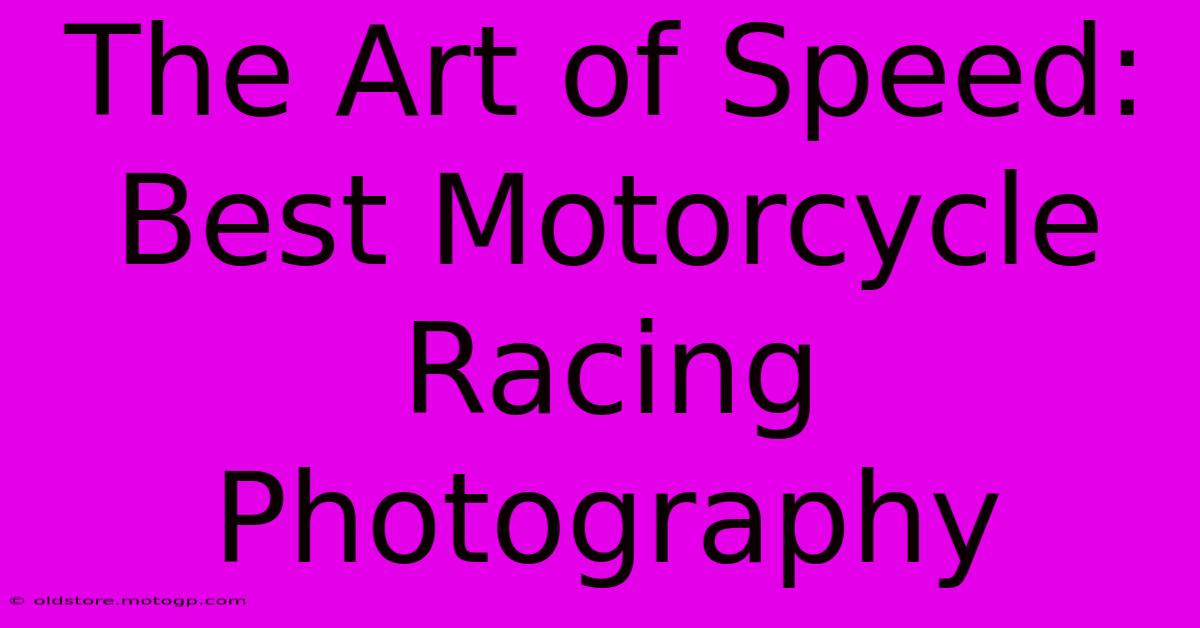The Art Of Speed: Best Motorcycle Racing Photography

Table of Contents
The Art of Speed: Best Motorcycle Racing Photography
Motorcycle racing: a symphony of roaring engines, blurring speed, and breathtaking skill. Capturing the essence of this exhilarating sport demands more than just pointing a camera; it requires a mastery of timing, technique, and an artist's eye. This article delves into the art of motorcycle racing photography, exploring the key elements that separate snapshots from stunning, evocative images.
Freezing the Fury: Mastering Technique
The challenge in motorcycle racing photography lies in capturing the incredible speed and dynamic movement. A sharp image, frozen in time, is paramount. This necessitates a fast shutter speed, typically exceeding 1/1000th of a second, often much faster depending on the bike's speed and the desired level of motion blur.
Essential Gear for the Job:
- High-speed DSLR or Mirrorless Camera: A camera capable of rapid continuous shooting is essential to capture the perfect moment amidst a flurry of action.
- Telephoto Lens: A long telephoto lens (at least 70-200mm, ideally longer) is crucial for isolating the bikes and riders from the background, creating compelling compositions.
- Fast Aperture Lens: A wide maximum aperture (e.g., f/2.8 or faster) allows for faster shutter speeds in low-light conditions and creates a shallow depth of field, blurring the background and emphasizing the subject.
- Monopod or Tripod (with a gimbal head): These are helpful for stabilizing the camera, particularly when using long telephoto lenses. A gimbal head is particularly useful for smooth panning shots.
Beyond the Basics: Composition and Creativity
Technical proficiency is only half the battle. Great motorcycle racing photography transcends mere documentation; it tells a story.
- Leading Lines: Use natural lines like the track itself or barriers to draw the viewer's eye towards the main subject.
- Rule of Thirds: This classic compositional guideline helps create visually appealing and balanced images.
- Dynamic Angles: Experiment with different shooting angles – low angles emphasize speed and power, while higher angles provide a broader view of the race.
- Capturing Emotion: Look beyond the machines; try to capture the emotions of the riders – their concentration, determination, and exhilaration. A rider's expression can dramatically enhance the narrative of the photograph.
The Art of Light and Shadow: Working with the Environment
The lighting conditions at a motorcycle race can vary dramatically. Understanding how to work with available light is crucial.
- Golden Hour: The periods shortly after sunrise and before sunset offer soft, warm light ideal for creating dramatic and atmospheric images.
- Overcast Days: Diffused light on overcast days can be beneficial, eliminating harsh shadows and allowing for more consistent exposure.
- Using Fill Flash: A flash can help illuminate subjects in shadow, adding detail and depth to your photos. However, careful consideration is needed to avoid overexposed highlights.
Post-Processing: Enhancing Your Masterpieces
Post-processing plays a vital role in bringing out the best in your motorcycle racing photographs.
- Sharpening: Carefully sharpen your images to enhance detail and clarity, particularly in areas like the rider's helmet or the motorcycle's wheels.
- Color Correction: Adjust the white balance and color saturation to achieve the desired mood and atmosphere.
- Cropping and Composition Refinement: Use cropping to fine-tune composition and improve the overall visual impact.
Beyond the Track: Sharing Your Work
Once you have captured the electrifying energy and raw power of motorcycle racing, it’s time to share your images with the world.
- Building a Portfolio: Create a compelling online portfolio showcasing your best work. This could be a dedicated website, or through platforms like Instagram or Flickr. Use relevant hashtags to increase visibility.
- Networking: Engage with other motorsport photographers and enthusiasts online. Attend races and network in person. Sharing your passion can open doors to collaborations and opportunities.
- Submitting to Publications: Consider submitting your best photographs to motorsport magazines or online publications.
Motorcycle racing photography is a challenging but incredibly rewarding pursuit. By mastering the technical aspects and developing your artistic eye, you can capture the thrilling beauty of this high-octane sport, creating images that will leave viewers breathless. Remember to prioritize safety at all times while shooting near high-speed vehicles.

Thank you for visiting our website wich cover about The Art Of Speed: Best Motorcycle Racing Photography. We hope the information provided has been useful to you. Feel free to contact us if you have any questions or need further assistance. See you next time and dont miss to bookmark.
Featured Posts
-
Yamaha V4 Moto Gp The Future Of Racing Technology
Feb 21, 2025
-
Ride Like A Champion Race Ready Motorcycles Available
Feb 21, 2025
-
Moto Gp Austin Your Complete Guide To Dates And Tickets
Feb 21, 2025
-
The Future Of Travel Is Here F1 Shuttle
Feb 21, 2025
-
Lot R Cota A Beginners Guide
Feb 21, 2025
